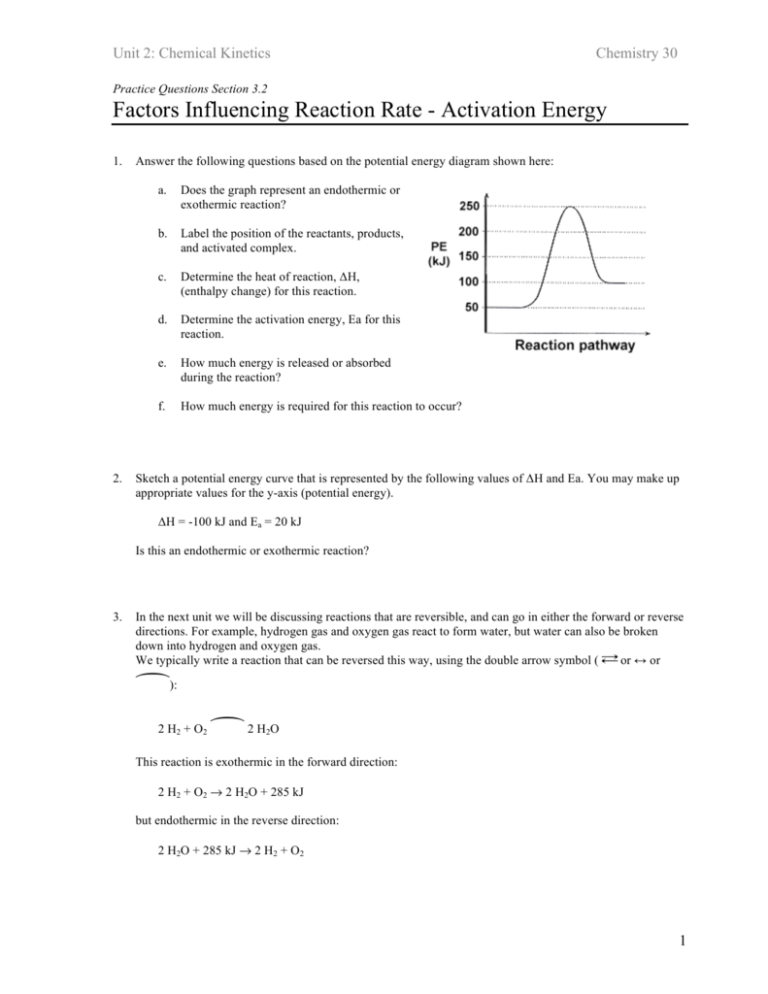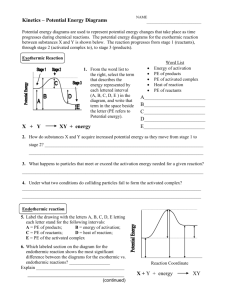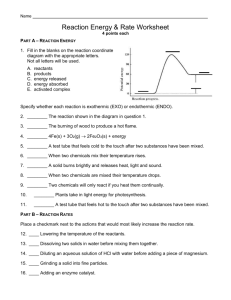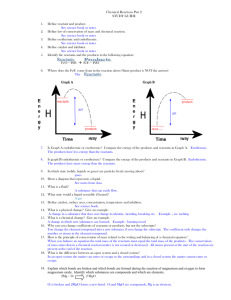Activation Energy Diagrams
advertisement

Unit 2: Chemical Kinetics Chemistry 30 Practice Questions Section 3.2 Factors Influencing Reaction Rate - Activation Energy 1. 2. Answer the following questions based on the potential energy diagram shown here: a. Does the graph represent an endothermic or exothermic reaction? b. Label the position of the reactants, products, and activated complex. c. Determine the heat of reaction, ΔH, (enthalpy change) for this reaction. d. Determine the activation energy, Ea for this reaction. e. How much energy is released or absorbed during the reaction? f. How much energy is required for this reaction to occur? Sketch a potential energy curve that is represented by the following values of ΔH and Ea. You may make up appropriate values for the y-axis (potential energy). ΔH = -100 kJ and Ea = 20 kJ Is this an endothermic or exothermic reaction? 3. In the next unit we will be discussing reactions that are reversible, and can go in either the forward or reverse directions. For example, hydrogen gas and oxygen gas react to form water, but water can also be broken down into hydrogen and oxygen gas. We typically write a reaction that can be reversed this way, using the double arrow symbol ( or ↔ or º): 2 H2 + O2 º2H O 2 This reaction is exothermic in the forward direction: 2 H2 + O2 → 2 H2O + 285 kJ but endothermic in the reverse direction: 2 H2O + 285 kJ → 2 H2 + O2 1 Unit 2: Chemical Kinetics Chemistry 30 Consider a general reversible reaction such as: A+B ºC+D Given the following potential energy diagram for this reaction, determine ΔH and Ea for both the forward and reverse directions. Is the forward reaction endothermic or exothermic? 4. Sketch a potential energy diagram for a general reaction A + B ºC+D Given that ΔHreverse = -10 kJ and Ea forward = +40 kJ 2 Unit 2: Chemical Kinetics Chemistry 30 Practice Questions Section 3.2 Factors Influencing Reaction Rate - Activation Energy 1. Answers Answer the following questions based on the potential energy diagram shown here: g. Does the graph represent an endothermic or exothermic reaction? h. Label the postion of the reactants, products, and activated complex. i. Determine the heat of reaction, ΔH, (enthalpy change) for this reaction. j. Determine the activation energy, Ea for this reaction. k. How much energy is released or absorbed during the reaction? l. How much energy is required for this reaction to occur? Solution a. The graph represents an endothermic reaction b. the reactants, products, and activated complex are shown c. ΔH = +50 kJ. Since this in an endothermic reaction, ΔH will have a positive value. ΔH is the difference in energy between the energy levels of the initial reactants (50 kJ) and the final products (100 kJ), and does not depend on the actual pathway (remember Hess's Law?) d. Ea = +200 kJ. Activation energy is the amount of energy required to go from the energy level of the reactants (50 kJ) to the highest energy point on the graph, the activated complex (250 kJ). e. 50 kJ of energy are absorbed during this endothermic reaction (this is the value of ΔH) f. 200 kJ of energy are required for this reaction to occur (Ea). Even though ΔH is only 50 kJ, enough energy must be supplied to reach the activated complex, or the reaction will not occur. 3 Unit 2: Chemical Kinetics 2. Chemistry 30 Sketch a potential energy curve that is represented by the following values of ΔH and Ea. You may make up appropriate values for the y-axis (potential energy). ΔH = -100 kJ and Ea = 20 kJ Is this an endothermic or exothermic reaction? Solution: Since ΔH is a negative number, we know that the reaction is exothermic. Therefore, begin by sketching an exothermic potential energy graph: Next, assign values to the y-axis that will satisfy our requirements, namely ΔH = -20 kJ and Ea = +60kJ Remember: ΔH is the difference between energy levels of the reactants and products - this difference will equal -20 kJ. Ea is the difference between energy levels of the initial reactants and the peak of the curve, the activated complex. 3. In the next unit we will be discussing reactions that are reversible, and can go in either the forward or reverse directions. For example, hydrogen gas and oxygen gas react to form water, but water can also be broken down into hydrogen and oxygen gas. We typically write a reaction that can be reversed this way, using the double arrow symbol ( or ↔ or º): 2 H2 + O2 º2H O 2 This reaction is exothermic in the forward direction: 2 H2 + O2 → 2 H2O + 285 kJ but endothermic in the reverse direction: 2 H2O + 285 kJ → 2 H2 + O2 4 Unit 2: Chemical Kinetics Chemistry 30 Consider a general reversible reaction such as: A+B ºC+D Given the following potential energy diagram for this reaction, determine ΔH and Ea for both the forward and reverse directions. Is the forward reaction endothermic or exothermic? Solution: You should immediately see that the forward reaction is exothermic - the products (C + D) are at a lower energy level than the reactants. 4. ΔHforward = -20 kJ the difference in energy level between the reactants and products. Ea forward = +60 kJ amount of energy required to go from the initial reactants A + B to the activated complex, the peak of the graph. ΔHreverse = +20 kJ difference in energy from C + D and A + B. Notice the value of ΔH does not change, only the sign. Ea reverse = +80 kJ amount of energy required to go from C + D to the activated complex. Sketch a potential energy diagram for a general reaction A + B ºC+D Given that ΔHreverse = -10 kJ and Ea forward = +40 kJ Solution: Begin by determining whether the forward reaction (A + B → C + D) is endothermic or exothermic: Since ΔHreverse = -10 kJ you can determine that ΔHforward = +10 kJ (same value, just change the sign). Since ΔHforward is positive you know that the forward direction of the reaction is endothermic. Begin by sketching a general endothermic potential energy curve that is endothermic. Don't worry about drawing to scale at this time: 5 Unit 2: Chemical Kinetics Chemistry 30 At what energy level should you put the activated complex, the top of the peak? Since Ea forward = +40 kJ, you know that from the initial reactants (A + B) you need to go up 40 energy units. Pick any value for a starting energy level (let's use a starting point of 10 here), then add 40 to find the peak of your graph (10 + 40 = 50). Return to ΔH to determine the energy level of the products. Since ΔHforward = +10 kJ, add 10 to our starting value to determine the energy level of the products: 6








